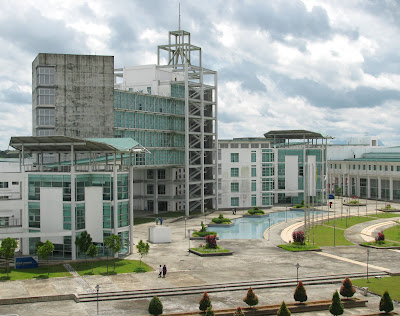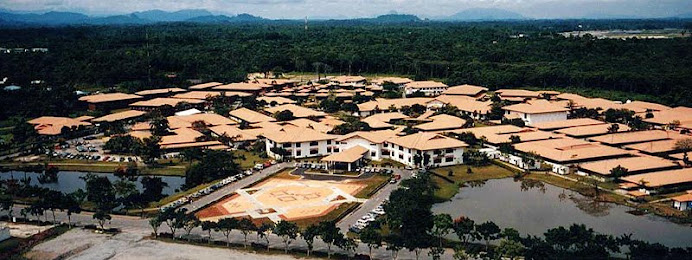Wednesday, March 11, 2009
Remaining Travel Schedule
March 12-17 Bali, Indonesia
March 20-23 Pontianak, West Kalimantan, Indonesia (9-hour bus ride south of Kuching)
March 28-31 Phuket, Thailand (with my Mom!)
April 9-15 Singapore
April 15, 19-20 Kuala Lumpur
April 16-18 Temerloh, Pahang, Peninsular Malaysia
May 5 Exams over, Check out of UNIMAS
May 5-9 Miri, Sarawak (Miri International Jazz Festival May 8-9)
May 10-14 Mulu National Park
May 15-16 Bandar Seri Begawan, Brunei
May 17 Labuan Island
May 18 Lawas, Sarawak
May 19-21 Ba Kelalan, Sarawak
May 22-27 Kota Kinabalu and around Sabah, Malaysia
May 27-31 Phnom Penh, Cambodia
June 1-2 Angkor Wat, Siem Reap, Cambodia
June 3-5 Bangkok, Thailand
June 5 Seattle, Washington, U.S. of A.
Tuesday, March 10, 2009
Sarawak FC
I knew enough about Malaysia not to expect any pro baseball, football, or hockey, but I thought basketball was a possibility. (Seon informed me that even South Korea has a pro basketball league, although - amusingly - each team is allowed a maximum of two foreign players, and before this year a rule banned anyone over 6'8'', i.e. the height of the tallest Korean player.) Soccer has never been among my favorites, but in recent years I've shed my prejudice and grown to appreciate this world's best loved sport. In many parts of the globe it's all they have in the way of pro sports, and that includes Sarawak.
 The Sarawak Football Club's heyday was in the '90s when their nickname was the Crocs. In 1999 they made their only appearance (losing to Brunei) in the prestigious Malaysia Cup, the longest-running soccer competition in Asia. Since then they have declined so much that last year, by which time they'd become the Hornbills, they faced the shame of losing their position in the Super League and being relegated to the second division of Malaysian national soccer, the 14-team Premier League.
The Sarawak Football Club's heyday was in the '90s when their nickname was the Crocs. In 1999 they made their only appearance (losing to Brunei) in the prestigious Malaysia Cup, the longest-running soccer competition in Asia. Since then they have declined so much that last year, by which time they'd become the Hornbills, they faced the shame of losing their position in the Super League and being relegated to the second division of Malaysian national soccer, the 14-team Premier League.Ten years ago they began playing in Kuching's impressive Sarawak Stadium which seats 40,000 and was built for the 1997 FIFA World Youth Cup. This venue is conspicuously and impractically large for a city the likes of Kuching.



 My friend and classmate Gary from Kuala Lumpur informed me about the game just a few hours before it started, and luckily I was free. We went for the cheap, uncovered seats (i.e., cement terraces) which cost me $2. Even though it rained, this turned out to be a good move because they allowed everyone into the covered seating regardless.
My friend and classmate Gary from Kuala Lumpur informed me about the game just a few hours before it started, and luckily I was free. We went for the cheap, uncovered seats (i.e., cement terraces) which cost me $2. Even though it rained, this turned out to be a good move because they allowed everyone into the covered seating regardless.
 Despite the low turnout, the game felt lively throughout thanks to the chants and beats provided by the Sarawak Football Fan Club. They played one bass drum and a couple dozen kompang, shallow single-skin hand drums of Malay origin. I've been informed that the best place to buy one is the Kuala Lumpur central market, so I plan to stop there next month.
Despite the low turnout, the game felt lively throughout thanks to the chants and beats provided by the Sarawak Football Fan Club. They played one bass drum and a couple dozen kompang, shallow single-skin hand drums of Malay origin. I've been informed that the best place to buy one is the Kuala Lumpur central market, so I plan to stop there next month.
 A local military marching band provided the halftime entertainment. (Any good football game has a marching band at halftime, right?) They were small and featured bagpipes and a baton wielding leader. I enjoyed their simple five-minute routine, but Gary was more interested in his dwindling supply of cheese puffs. He said his own high school marching band was better than these guys. Ditto man. Ditto.
A local military marching band provided the halftime entertainment. (Any good football game has a marching band at halftime, right?) They were small and featured bagpipes and a baton wielding leader. I enjoyed their simple five-minute routine, but Gary was more interested in his dwindling supply of cheese puffs. He said his own high school marching band was better than these guys. Ditto man. Ditto. Despite Sarawak's large indigenous and Chinese populations, nearly all the players on Sarawak FC are Malays. Sarawakians pride themselves on being significantly more racially integrated than Peninsular Malaysians, but sports here remain very much segregated. It can be said, for example, that soccer is for Malays and natives, whereas basketball is played almost exclusively by Chinese.
Despite Sarawak's large indigenous and Chinese populations, nearly all the players on Sarawak FC are Malays. Sarawakians pride themselves on being significantly more racially integrated than Peninsular Malaysians, but sports here remain very much segregated. It can be said, for example, that soccer is for Malays and natives, whereas basketball is played almost exclusively by Chinese.In the past Sarawak FC has had several Australians, a couple South Africans, a Scot, and a Brazilian, among other foreigners. (Players from at least 66 countries have played professional soccer in Malaysia, but never a single American!) In fact, teams had become dependent on their foreign players for scoring, as last year the top four leading scorers were non-Malaysian. It is quite unfortunate that the league's rules regarding foreigners are constantly changing, and the most recent ones ban imports altogether.
At one point near the game's end a slide tackle led to some shoving and exchanging of words, and I thought I would get to witness a soccer brawl – Malaysian style. It was not to be. We lost to visiting Terengganu 2 to 1.
Sunday, March 08, 2009
Climate

 Rain outside my class at the UNIMAS old campus:
Rain outside my class at the UNIMAS old campus:
Strangely, I've actually been underwhelmed by the amount of rain. A Pacific Northwest native, of course I'm used to rain, but somehow I expected rain during the rainy season in the rainiest city in Borneo to be like Seattle rain on 'roids. It hasn't been which is nice, plus I always appreciate having clouds around midday to block that brutal equatorial sun. With little variation the temperature is mid-80s in the day and mid-70s at night.
Kuching's rain is not so different from Seattle's, but its thunder is. The weather forecast for virtually every day that I've been here has been "T-storms," but rarely do thunder and lightning come near enough to campus that I'd say I'm in a thunderstorm. Those occasions, however, can be a bit frightening. The sharp thunder "claps" are ten times as loud as the low "booms" I'm used to. At first I found it odd that people kept telling me to be careful whenever I was heading outside at a time it was raining. That was before I found out that last year a UNIMAS student was struck by lightning and instantly killed just a half-mile from where my apartment building sits. She was using an umbrella and a cell phone at the time.
I must have had an exaggerated conception of 'tropical climate' before coming here; I've found it easier than expected to tolerate not only the amount of rain but also the level of heat. I do all my running and basketball either in the morning or evening, and midday I try to stay inside or under shade. I would be wearing shorts 100% of the time if it weren't for the expectation that to class and inside the library men wear long pants, which I find uncomfortably hot when outdoors. But overall the heat rarely bothers me. In fact, some of my classes are so heavily air-conditioned that I've learned to bring along my jacket.

 Below is the main entrance to the library. From a distance the windows look frosted, but up close it becomes clear that it's just condensation on the glass.
Below is the main entrance to the library. From a distance the windows look frosted, but up close it becomes clear that it's just condensation on the glass.
 The tropical humidity has its pros and cons.
The tropical humidity has its pros and cons.Con: When walking outdoors at my normal pace I start sweating in about three minutes.
Con: The lens of my camera fogs up real bad when moved outdoors from an air-conditioned room.
Pro: I can get sweet photo effects without any fancy software.
 All in all, I find the weekly weather forecasts for Kuching – which invariably read "High of 86, T-storms, 80% chance of precipitation" – to be misleading. I'm grateful that neither the rain nor the heat nor the lightning (knock on wood) has much impeded my activities here.
All in all, I find the weekly weather forecasts for Kuching – which invariably read "High of 86, T-storms, 80% chance of precipitation" – to be misleading. I'm grateful that neither the rain nor the heat nor the lightning (knock on wood) has much impeded my activities here.

